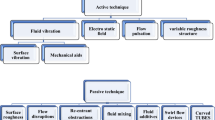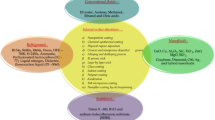Abstract
This paper presents the important results of enhancing the boiling heat transfer of the pressurized water reactors (PWRs) by using LIGA or LIGA-like techniques to add microstructures on the surface of heater elements. The heater elements were made of 10 mm × 80 mm silicon strips with different in-line square micro-pin-fin configurations of 200 μm fin width, 35 μm fin height, and different inter-fin spacing values of 200, 400, 600, 800, 1000 μm and infinity. The experiments were conducted in de-ionized water at the atmospheric pressure. The input power, heater temperature, steam generation rate and video images of boiling phenomena were continuously recorded. Their relationships was studied and used to evaluate the total boiling heat transfer performance. The optimized microstructures can then be mass-fabricated on PWR tubes by using LIGA or LIGA-like technology. The experimental results suggest that by adding micro-sized in-line pin-fin arrays on heater surface and modifying heater surface morphology, the boiling process can be greatly enhanced through the improvements of vapor nucleation and vapor evolution processes at heater surface, which yields a low wall superheat and achieves a higher boiling heat transfer efficiency. The video images showed that the bubble nucleation sites are located immediately on top of each micro-pin fins. At current experimental setup, the 200 μm-spacing heater has the highest steam generation efficiency.








Similar content being viewed by others
Abbreviations
- A b :
-
heater base area or projection area (cm2)
- g′:
-
weight loss of liquid (g)
- h :
-
pin-fin height (μm)
- P :
-
input electrical power (W)
- q″:
-
heat flux based on heater projection area (A b), q″ = P/A b (W/cm2)
- s :
-
inter-fin spacing (μm)
- T w :
-
wall temperature (°C)
- T sat :
-
liquid saturation temperature or boiling temperature (°C)
- ΔT :
-
wall superheat, ΔT = T − T sat (°C)
- w :
-
square pin-fin side width (μm)
References
Bahrami M, Yovanovich MM, Culham JR (2005) Role of random roughness on thermal performance of micro-fins. Proceedings of heat transfer conference, San Fransisco, CA, USA, July 2005
Chatpun S, Watanabe M, Shoji M (2004) Nucleation site interaction in pool nucleate boiling on a heated surface with triple artificial cavities. Int J Heat Mass Transf 47:3583–3587
El-Genk MS, Parker JL (2005) Enhanced boiling of HFE-7100 dielectric liquid on porous graphite. Energy Convers Manag 46:2455–2481
Honda H, Wei JJ (2004) Enhanced boiling heat transfer from electronic components by use of surface microstructures. Exp Therm Fluid Sci 28:159–169
Honda H, Takamatsu H, Wei JJ (2002) Effect of the size of micro-pin-fin on boiling heat transfer from silicon chips immersed in FC-72. Proceedings of the 12th international heat transfer conference, Grenoble, France, pp 75–80, August 2002
Hubner P, Kunstler W (1997) Pool boiling heat transfer at finned tubes: influence of surface roughness and shape of the fins. Int J Refrig 20(8):575–582
Jiang YY, Wang WC, Wang D, Wang BX (2001) Boiling heat transfer on machined porous surfaces with structural optimization. Int J Heat Mass Transf 44:443–456
Kim J, You SM, Pak JY (2006) Effects of heater size and working fluids on nucleate boiling heat transfer. Int J Heat Mass Transf 49:122–131
Lian K, Jiang JC, Ling ZG (2007) Processing-microstructure-resulting materials properties of LIGA Ni. Microsyst Technol 13:259–264
Melendez E, Reyes R (2006) Interfacial energies of aqueous mixtures and porous coverings for enhancing pool boiling heat transfer. Int J Therm Sci 45:796–803
Mitrovic J, Hartmann F (2004) A new microstructure for pool boiling. Superlattice Microstruct 35:617–628
Murthy S, Joshi Y, Gurrum S, Nakayama W (2006) Enhanced boiling heat transfer simulation from structured surfaces: semi-analytical model. Int J Heat Mass Transf 49:1885–1895
Nukiyama S (1934) Maximum and minimum values of heat Q transmitted from metal to boiling water under atmospheric pressure. J Soc Mech Eng Jpn 37(53–54):367–374
Puers B, Sansen W (1990) Compensation structures for convex corner micromachining in silicon. Sens Actuators A21–A23:1036–1041
Rainey KN, You SM (2001) Effects of heater size and orientation on pool boiling heat transfer from microporous coated surfaces. Int J Heat Mass Transf 44:2589–2599
Rainey KN, You SM, Lee S (2003) Effect of pressure, subcooling and dissolved gas on pool boiling heat transfer from microporous, square pin-finned surfaces in FC-72. Int J Heat Mass Transf 46:23–35
Rajulu KG, Kumar R, Mohanty B, Varma HK (2004) Enhancement of nucleate pool boiling heat transfer coefficient by reentrant cavity surfaces. Heat Mass Transf 41:127–132
Ramaswamy C, Joshi Y, Nakayama W, Johnson WB (2002) High-speed visualization of boiling from an enhanced structure. Int J Heat Mass Transf 45:4761–4771
Shoji M, Takagi Y (2001) Bubbling features from a single artificial cavity. Int J Heat Mass Transf 44:2763–2776
Wei JJ, Guo LJ, Honda H (2005) Experimental study of boiling phenomena and heat transfer performances of FC-72 over micro-pin-finned silicon chips. Heat Mass Transf 41:744–755
Yang J, Cheung FB, Rempe JL, Suh KY, Kim SB (2006) Critical heat flux for downward-facing boiling on a coated hemispherical vessel surrounded by an insulation structure. Nucl Eng Tech 38(2):139–146
Yu CK, Lu DC (2007) Pool boiling heat transfer on horizontal rectangular fin array in saturated FC-72. Int J Heat Mass Transf 50:3624–3637
Acknowledgments
This study was sponsored by a grant from U.S. Department of Energy, Award No. DE-FG52-05N27041. The authors also acknowledge the State of Louisiana for the financial support. Thanks also go to the CAMD/LSU for supporting this research.
Author information
Authors and Affiliations
Corresponding author
Rights and permissions
About this article
Cite this article
Zhang, M., Lian, K. Using bulk micromachined structures to enhance pool boiling heat transfer. Microsyst Technol 14, 1499–1505 (2008). https://doi.org/10.1007/s00542-007-0531-x
Received:
Accepted:
Published:
Issue Date:
DOI: https://doi.org/10.1007/s00542-007-0531-x




